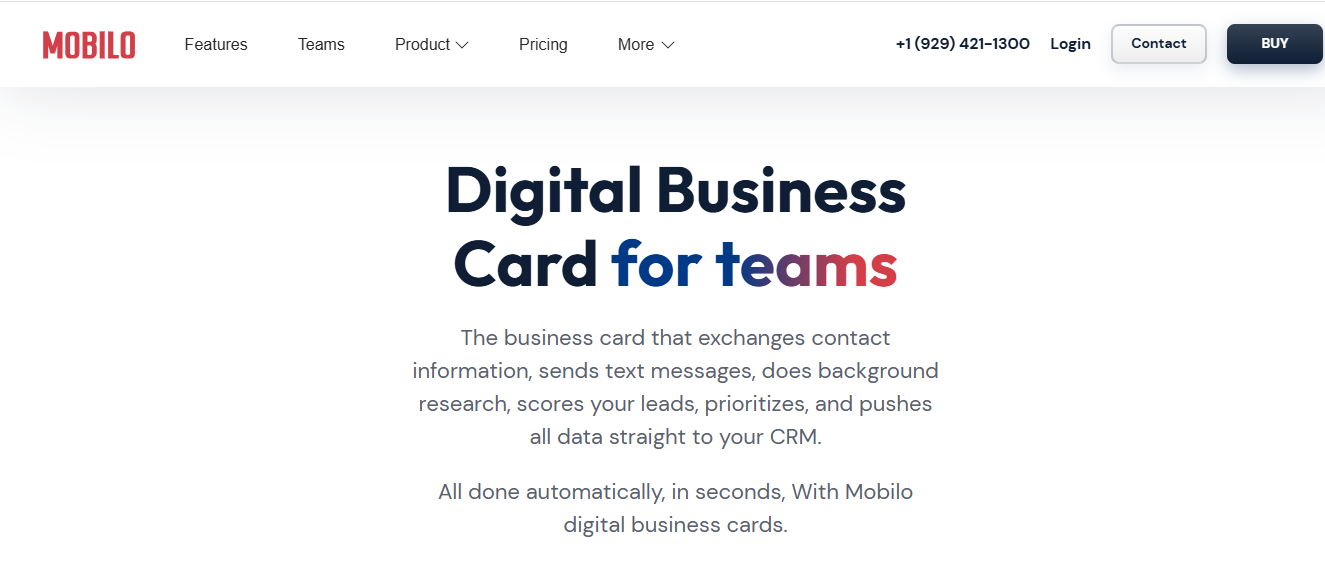.svg)

At networking events or a busy trade show, a single tap can exchange contact details, yet too often that tap becomes a lost card, and no follow-up occurs. Within NFC Technology, professional networking strategies shift from paper cards to instant exchanges that track and convert leads into genuine relationships. This article provides clear strategies to help you establish strong, meaningful professional connections that open doors to new opportunities, ongoing growth, and long-term success.
Mobilo's digital business card helps you share details with a tap, capture contact information, and follow up faster so connections turn into real opportunities. It also makes it easy to present your personal brand, sync with LinkedIn, and manage contacts without the need for paper or messy spreadsheets.

Professional networking is the deliberate practice of building and maintaining relationships that help you grow your career, share knowledge, and uncover opportunities; it includes both intentional outreach and the small interactions that compound into trust.
You do it at conferences, in alumni groups and virtual events, on platforms like LinkedIn and X, and in everyday workplace conversations where a single introduction can change a trajectory.
Networking happens wherever people exchange value, not just at formal mixers. Think industry conferences, association meetings, employer open houses, online student and alumni groups, virtual professional events, and the social feeds where you publish thought leadership.
Even a quick contact transfer at a trade show or a tap with an NFC-enabled card becomes part of your relationship history once it’s routed into a CRM. Those moments are raw material; what matters is how you capture and act on them.
Networking delivers access to mentors who accelerate learning, referrals that open doors, early signals about hiring or product shifts, and the informal endorsements that shape your reputation.
According to HubSpot, 85% of jobs are filled through networking, highlighting the central role relationships play in the hidden job market, rather than advertised openings. When you treat networking as pipeline work, not polite small talk, it becomes a measurable growth channel.
Ask the right questions and listen, then become the person who shows up with practical help. Offer concrete value, such as a relevant contact, an article, or a brief critique that saves someone time. Publish practical insights consistently so your name becomes shorthand for a specific competence.
Use mutual introductions to establish new connections and track interactions so that follow-ups occur while the conversation remains relevant. Think of your brand as a ledger of trust, where every meaningful exchange earns you credibility and future influence.
When you scale events from tens to hundreds of contacts, manual processes reveal their cost, like delayed outreach, inconsistent messaging, and lost attribution for what actually generated a lead.
This pattern is evident across trade shows and in-house events, where prioritizing administrative convenience over efficient routing leads to conversion shortfalls and leaves teams blaming the vendor, rather than the workflow. It’s exhausting when promising conversations shrink to orphaned spreadsheet rows.
Thinking networking only happens at formal events, believing you need a massive contact list, or assuming every interaction should be a quick pitch. These myths distract from repeatable practices that scale influence and create a pipeline.
According to Forbes, approximately 80% of professionals consider networking essential for career success, so the focus should be on consistent, strategic engagement rather than flashy volume.

Effective networking requires intention and steady follow-through; you must plan interactions, measure outcomes, and revisit the work repeatedly. Below are 13 specific strategies you can apply now, each outlining how to act, why it works, and what to measure. Hence, networking becomes a predictable pipeline instead of a random favor.
Frame a clear niche statement, publish two helpful posts a month, and keep a single, updated portfolio link on all profiles. Consistent content turns one-off introductions into recognizably repeatable value, and that recognition shortens the trust window at events. Track engagement by noting who comments, then route those names into your CRM or contact list with a tag for follow-up priority.
Ask three open questions that reveal needs, not résumés, and mirror back one specific phrase to show you listened. This converts shallow small talk into signals you can act on later, because people remember the person who understood a problem. Record one key insight per conversation in your notes so follow-up references feel personal and timely.
Keep a “help inventory” of three things you can offer (an intro, a short review, or a relevant article) and use it within 48 hours of meeting someone. Reciprocity compounds when offers are concrete and timely. Measure success by counting replies that request your help within two weeks.
Publish short, tactical posts that solve a single problem for your target audience, and repurpose that post as an email to new contacts. Practical content becomes a conversation starter and a credibility asset; it lets you lead with value rather than ask for favors. Track which pieces generate requests for meetings, then double down on them.
Ask for a warm introduction that includes a one-line context sentence and a suggested next step, such as a 15-minute call. Warm intros cut cold outreach response rates in half or better because they transfer credibility. Keep a log of introducers and outcomes to identify which people reliably open doors.
Identify three target roles, two specific people you want to meet, and one conversational hook tailored to the event. Direct, intentional presence converts volume into quality because you avoid scattershot interactions that never get followed up on. After the event, prioritize contacts by signal strength and schedule follow-ups within 72 hours.
Treat LinkedIn and targeted networking apps as signal amplifiers:
Social platforms facilitate relationship maintenance, but they only work when interactions are followed up on. Use tags, sequences, and a CRM field that records the platform and message that sparked the connection.
Pick one organization, serve a committee role for one year, and run one small event or panel. The constraint-based tradeoff is clear. Do one deeper role rather than hold many superficial memberships, because embedded roles give you trusted visibility and first-call introductions. Measure effectiveness by the number of qualified referrals you get per quarter.
Set a concrete goal, such as scheduling three meaningful conversations and one follow-up meeting, and use breakout rooms to collect two direct quotes that you can reference later. Virtual settings reward premeditated follow-up because the initial interaction often lacks ambient context. Keep a concise template for follow-up messages to ensure outreach is both fast and personal.
Craft a 30-second script that states who you help, the outcome you create, and the one next step you want, then A/B test it across five events. The how is variation and measurement. The reason is repeated.
Tested pitches reduce cognitive load under pressure and increase conversion to the next steps. Record which pitch phrasing leads to meetings and standardize the best version.
Prepare three audience-specific hooks for each archetype you expect to meet, and swap them in based on the first 30 seconds of conversation. This tailors your relevance quickly and prevents the “one-size-fits-all” pitch that audiences tune out. Use quick tags in your contact notes to capture which hook worked for future reference.
Solid posture, clear audio and lighting for video, and a single-line visual one-pager or LinkedIn URL to share. First impressions are predictable and repeatable, so invest in a short checklist you run before every meeting. Track whether meetings that start with a visual asset convert at higher rates.
Ask one diagnostic question and one aspirational question, then summarize the answer before you offer anything. Good questions create a cognitive debt that leads the other person to reciprocate with time or introductions. Follow up within 24 to 48 hours with a message that references a specific detail and recommends one explicit following action, then log the outcome in your CRM.
Maintain a 90-day engagement plan for each tier of contact:
This pattern eliminates random check-ins and replaces them with predictable lifecycle activities that maintain momentum.
When volume increases, shift your focus from chasing new contacts to converting existing relationships by conducting quarterly reviews of your top 50 contacts, pruning low-signal names, and deepening high-signal ones. That constraint improves conversion because depth compounds while quantity dilutes.
Audit your public profiles quarterly, align your privacy and professional content, and ensure your shared portfolio link is up to date. Recruiters and partners check public presence; controlled, consistent signals reduce friction in hiring and partnerships.

You are not broken for feeling anxious, unsure, or drained around networking; you can use practical, low-pressure techniques to start conversations, protect your energy, and turn a few intentional interactions into measurable follow-up without performing at every event.
When the first line feels like a high wire, shrink it down. Open with a micro-request that asks for one concrete thing, for example, "Who on your team owns product partnerships?" That single, specific ask gives the other person an easy role to play and reduces the risk you feel when trying to perform.
Use a two-sentence script that you rehearse five times before the event, so the wording becomes automatic. Also, carry an NFC card that preloads your role, a one-sentence value statement, and a suggested next step. The tap does the heavy lifting, so you only need to offer a short human comment, not a pitch.
This challenge appears at conferences and hiring fairs, where sensory overload trips the nervous system and conversation shuts down. Treat your social energy like a battery. Plan three meaningful interactions, then recharge for 20 minutes in a quiet corner.
Use visual affordances to reduce pressure, such as a simple one-line card or a badge that signals whether you prefer a quick exchange or a more extended conversation.
Let the NFC tap carry your full context, allowing you to avoid extended eye contact if that helps. Small environmental choices, such as standing near exits or choosing seating with your back protected, can reduce the subjective intensity without altering outcomes.
This pattern appears across professionals who want relationships but dread the maintenance work; when follow-up feels like a fog, it gets postponed. Note that 50% of people find it challenging to maintain their professional network, which explains why automated capture and clear triage are more critical than ever. Saving a contact is only helpful if you can act on it.
Use immediate, automated routing into a CRM so that the moment you meet someone, their profile is created as a task, not a fuzzy mental note. Then, assign each new contact a simple triage tag, such as 'urgent,' 'relevant,' or 'archive,' and let automation handle the rest until you can personalize your outreach.
This pattern appears in training rooms where shy people freeze at the first objection; the failure mode is rehearsing grand speeches instead of tiny experiments. Run five low-stakes experiments over two weeks. Send five tailored messages to new contacts, vary one sentence, and note which phrasing gets replies.
That constraint forces fast learning, and the wins rebuild confidence. Additionally, consider role-based volunteering at events, which creates scripted openings and immediate purpose, turning encounters into predictable handoffs rather than improvisational stress tests.
If preserving bandwidth is the goal, consider adopting bite-sized systems that create momentum without requiring daily effort. Use calendar-triggered nudges to follow up at 24 and 72 hours, templates that insert one personalized detail, and automatic lead scoring so you only dig deep where signals exist.
Build a two-field ICP tag, one for role and one for interest, and use that to filter monthly outreach into a 10-minute routine. Over time, those micro-systems compound into a reliable pipeline without asking you to be constantly 'on'.

We both know how many good conversations vanish when follow-up slips, so if you want networking to behave like a measurable pipeline rather than a stack of paper, consider Mobilo, which moves contact capture from tap to CRM in seconds while keeping the sharing experience accessible and optimized for devices like iPhones.
Book a demo, join more than 59,000 companies who switched, and get started with 25 Cards Free, so your team can pilot real event workflows without the paperwork.